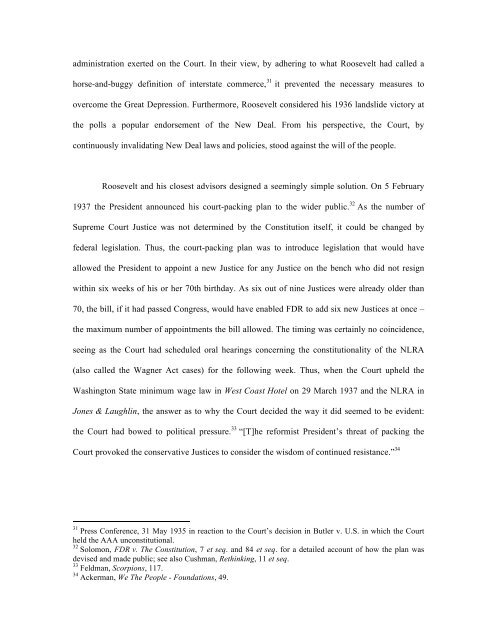Jasper Finke, Crisis and Law - New York University School of Law
Jasper Finke, Crisis and Law - New York University School of Law
Jasper Finke, Crisis and Law - New York University School of Law
You also want an ePaper? Increase the reach of your titles
YUMPU automatically turns print PDFs into web optimized ePapers that Google loves.
administration exerted on the Court. In their view, by adhering to what Roosevelt had called a<br />
horse-<strong>and</strong>-buggy definition <strong>of</strong> interstate commerce, 31 it prevented the necessary measures to<br />
overcome the Great Depression. Furthermore, Roosevelt considered his 1936 l<strong>and</strong>slide victory at<br />
the polls a popular endorsement <strong>of</strong> the <strong>New</strong> Deal. From his perspective, the Court, by<br />
continuously invalidating <strong>New</strong> Deal laws <strong>and</strong> policies, stood against the will <strong>of</strong> the people.<br />
Roosevelt <strong>and</strong> his closest advisors designed a seemingly simple solution. On 5 February<br />
1937 the President announced his court-packing plan to the wider public. 32 As the number <strong>of</strong><br />
Supreme Court Justice was not determined by the Constitution itself, it could be changed by<br />
federal legislation. Thus, the court-packing plan was to introduce legislation that would have<br />
allowed the President to appoint a new Justice for any Justice on the bench who did not resign<br />
within six weeks <strong>of</strong> his or her 70th birthday. As six out <strong>of</strong> nine Justices were already older than<br />
70, the bill, if it had passed Congress, would have enabled FDR to add six new Justices at once –<br />
the maximum number <strong>of</strong> appointments the bill allowed. The timing was certainly no coincidence,<br />
seeing as the Court had scheduled oral hearings concerning the constitutionality <strong>of</strong> the NLRA<br />
(also called the Wagner Act cases) for the following week. Thus, when the Court upheld the<br />
Washington State minimum wage law in West Coast Hotel on 29 March 1937 <strong>and</strong> the NLRA in<br />
Jones & Laughlin, the answer as to why the Court decided the way it did seemed to be evident:<br />
the Court had bowed to political pressure. 33 “[T]he reformist President’s threat <strong>of</strong> packing the<br />
Court provoked the conservative Justices to consider the wisdom <strong>of</strong> continued resistance.” 34<br />
31<br />
Press Conference, 31 May 1935 in reaction to the Court’s decision in Butler v. U.S. in which the Court<br />
held the AAA unconstitutional.<br />
32<br />
Solomon, FDR v. The Constitution, 7 et seq. <strong>and</strong> 84 et seq. for a detailed account <strong>of</strong> how the plan was<br />
devised <strong>and</strong> made public; see also Cushman, Rethinking, 11 et seq.<br />
33<br />
Feldman, Scorpions, 117.<br />
34 Ackerman, We The People - Foundations, 49.
















